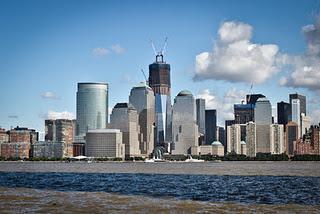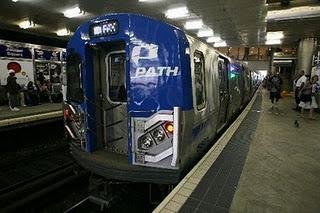
1 World Trade Center under construction
Driversapproaching lower Manhattan in 2011 have seen the steady rise of a newskyscraper, 1 World Trade Center. By December its steel superstructure alreadystood over 1,100 feet above street level, dominating the famous skyline aroundit. When the building is “topped out” next year it will be the tallest buildingin the United States (in fact the tallest in the entire western hemisphere). 1 World Trade Center is the most spectacularpart of the massive World Trade Center redevelopment effort, which includesseveral other towers, the National September 11 Memorial & Museum (thememorial is open but the museum is still under construction), and a soon-to-be-completedtransportation hub (road/rail/bus terminal). These are just some of thetangible signs that after a decade New York City has largely (physically) recoveredfrom the 9/11 attacks.Drivers Sue the World Trade Center?
Notlong after 1 World Trade Center peeked above the surrounding buildings, theAmerican Automobile Association (AAA), a service and advocacy group for over 50million drivers, sued the Port Authority of New York and New Jersey (PANYNJ). Why?Well this fall PANYNJ announced significant toll increases, up to 50%, on itsmany New York area bridges and tunnels, which include the heavily trafficked Lincolnand Holland tunnels and George Washington Bridge. The higher tolls were needed,according to PANYNJ, to pay for ongoing facility maintenance and planned improvementsand to cover some of the cost of the World Trade Center construction. You see,in addition to bridges, tunnel, airports, seaports, and transit, PANYNJ also owns several commercial properties the most visible being the World trade Centersite. The AAA lawsuit claimed that the PANYNJ toll increases were an unfairburden to drivers and that toll revenues would be diverted from the bridges andtunnels that toll payers use to unrelated commercial enterprises. In otherwords, and rather nefariously in AAA’s eyes, 1 World Trade Center was risinghigh above Manhattan on the dime of drivers who would never benefit from thedevelopment.
PANYNJhas countered that in fact they misspoke and all of the revenue raised fromincreased tolls will be used on their transportation facilities and not a nickelto pay for the World Trade Center construction. Both sides argued their case incourt last week and a ruling on the issue might be made by the end of the year.In light of PANYNJ’s modified account of how the toll revenues will be used, Iforesee the new toll rates being upheld and no refunds for any AAA drivers, butI’m not a lawyer and won’t wager on any particular outcome.
Thiswhole case may seem like one advocacy group attacking one issue from one publicagency, but I think it’s a microcosm of a larger debate being held in manyforms nationwide. Namely, when it comes to public money, whether it’s tolls ortaxes, whose money is it and who gets to decide how it will be spent? In the2010 U.S. midterm elections, Republicans across the country benefited greatlyfrom a broad grassroots effort, the Tea Party movement, which essentiallyargued that elected officials and public agencies were incapable of responsiblyusing tax dollars. And therefore, all tax increases were unacceptable and majorspending programs dubious. On the national level we’ve seen the results of lastyear’s elections: A tooth-and-nail struggle to get any spending programspassed through Congress, and none of those that eventually were passed included any taxincreases. Clearly one’s sympathy or antipathy to the Tea Party movement’sagenda rests in your political and fiscal perspective, but this is one of thefundamental arguments in America today.
Whose Money is It?
Sogoing back to the core question, whose money is it and who has the right to decidehow it is spent?
Legally, of course, the state (federal, state, local) has aright to levy taxes. An offshoot of this legal right relevant to the AAA-PANYNJlawsuit, is individual states also have right to allow agencies (public orprivate) to charge tolls on roads, bridges, tunnels, and other transportation facilities.The general reaction to taxes might range from annoyance to abhorrence, butthere is little argument that they are, to one extent or another, a necessity. Afterall, it’s hard to envision police, firemen, local roads, streetlights, andother basic services being provided by the private sector. Not to mention “big”items like say, the military or social programs that most would agree fallwithin the state’s responsibility.
Whata tax reformer would argue is that without better limitations on how governmentspends this revenue, massive inefficiencies and waste will result. Keeping inthe transportation theme, we’ll just end up with more boondoggles like thenotorious “Bridge to Nowhere.” This is the point of the AAA lawsuit. PANYNJ isusing toll revenues and not reinvesting those funds into the facilities thatthe toll payers use. The flip side of the argument is that handcuffing how thegovernment spends tax revenues can preclude the ability to funnel money intoneeded programs and resources. For instance, in the case of PANYNJ, assumingthey are using toll revenues to pay for the World Trade Center site, might thatinvestment ultimately payoff in commercial rents that will cover the initial projectcosts and raise large revenues in the long-term?

PATH service paid for by PANYNJ toll-paying drivers
Andconsider a specific example that raises a similar, but stickier question. Regardless of how the AAA-PANYNJlawsuit turns out, PANYNJ will still be responsible for maintaining andoperating its many facilities, including the PATH rail transit service between NewJersey and New York. This service is essentially subsidized by the tolls paidby PANYNJ users. The PATH user fees do not cover the PATH costs. So drivers aresubsidizing transit users. Did you know this was a fact true for every transit service in theUnited States? Transit service is mostly paid for by drivers through tolls, fees, or gastaxes. A Tea Partier (and maybe AAA) would argue that drivers are beingunfairly burdened by paying for other modes of transportation. A transitadvocate would claim that transit service improves overall regionaltransportation and is indispensible for regional mobility and economic growth.Who’s right? How should transportation money be spent? I’ve focused this poston a transportation issue, but you could apply the argument to any aspect of public spending.It seems you can’t go through a day without hearingor reading about the issue of government finances, spending, debt, andlong-term fiscal security. The issue of how government raises money, how it’s spent,who pays, and who benefits is going to dominate public discourse in the comingyears as much as 1 World Trade Center will dominate the skyline of lowerManhattan. History might prove the well-learned cliché that nothing is morecertain in life than taxes, but if the AAA lawsuit, the Tea Party movement, andthe raging debt crisis are any indication, a business-as-usual approach for howthose taxes are spent is far less assured.

